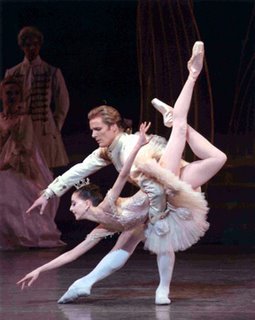 I remember my first ballet because it was the ENB's Sleeping Beauty on Friday at the New Theatre, Oxford. I went to the ballet for two reasons: 1) Tchaikovsky is my favourite composer, and 2) I saw a televised version of the Nutcracker which blew me away. It was a potent combination of a composer I love and dance to make my jaw drop. To anyone who hasn't seen a ballet and thinks it's pretentious self-congratulatory faux high art, I urge you to reconsider. The ballet was rivetting from start to finish. Then again, perhaps I'm a dilettante and I don't know my hutus from my piroulettes. For all I know, the critics could have done what they do best - pan it from here to Alaska.
I remember my first ballet because it was the ENB's Sleeping Beauty on Friday at the New Theatre, Oxford. I went to the ballet for two reasons: 1) Tchaikovsky is my favourite composer, and 2) I saw a televised version of the Nutcracker which blew me away. It was a potent combination of a composer I love and dance to make my jaw drop. To anyone who hasn't seen a ballet and thinks it's pretentious self-congratulatory faux high art, I urge you to reconsider. The ballet was rivetting from start to finish. Then again, perhaps I'm a dilettante and I don't know my hutus from my piroulettes. For all I know, the critics could have done what they do best - pan it from here to Alaska.Most people know the story of Sleeping Beauty and her Prince Charming. Imagine the story reworked, not by a soporific underpaid nursery school teacher, but acted out in dance form, set to the genius of Tchaikovsky by dancers who looked like they were enjoying themselves on stage, despite the technical difficulty of what they were doing. Watching them, I felt inspired - like I should be on stage also, prancing about in my tutu.
It is easy to see how art such as ballet and classical music become so-called high art, understood and patronised only by an affluent blue blood elite. The reflections are of the pomp and pageantry of a bygone era. A land awash with supine servants, court jesters, sycophantic advisers (almost sounds Blair-like), and a throne whose word was yea and amen. Only people with ties to that era, who feel such art is reflective of their past or present (insular) history, or yearn for a return to that past can appreciate it. Art should make us question our surroundings, regardless of historical context. The only attraction ballet might have for the ordinary man is in its aesthetic beauty, but it'll be a shame for such beauty to lack deeper meaning due to its "high art" leaning. Bring on Nutcracker!
No comments:
Post a Comment